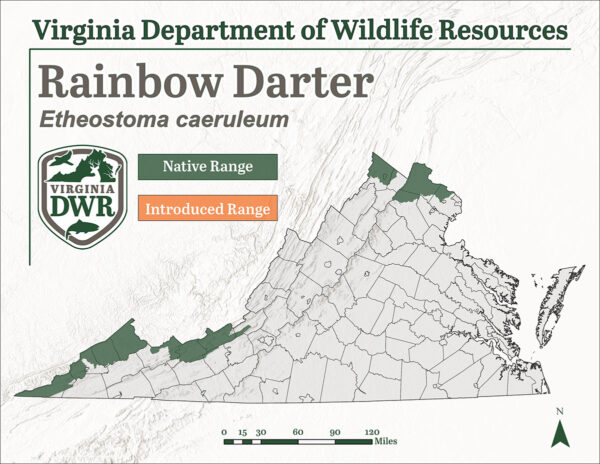A Rainbow Darter being observed biologists in a holding tank. ©Madison Cogar - DWR
A Rainbow Darter being released. ©Tim Aldridge
Fact File
Scientific Name: Etheostoma caeruleum
Classification: Fish, Order Perciformes, Family Percidae
Size: Rainbow Darters in Virginia average 1.5 to 3 inches in length
Life Span: Rainbow Darters in Virginia can live for about 4 years
Identifying Characteristics
- Moderately robust in body shape
- Two dorsal fins
- Spiny front dorsal has a thick turquoise margin
- Second dorsal has a thin turquoise margin, with orange radiating out from the base
- Medium sized mouth, with a frenum present
- Turquoise bars with areas of orange-red between
- Two orange spots at the base of the caudal (tail) fin
- Incomplete lateral line
Habitat
Like other members of the darter family, the Rainbow Darter is a benthic (bottom-dwelling) species of fish, and specializes in using the gaps between rocky stream substrates for protective cover and opportunistic feeding. Rainbow Darters require clean, fast moving water and are considered an indicator species of overall watershed health, as their required habitat is degraded by erosion and siltation.
Diet
Rainbow Darters often feed on an array of benthic macroinvertebrates such as Caddisflies, Mayflies, and Stoneflies.
Distribution:
Rainbow Darters have a limited distribution within Virginia, found only within certain areas of the Big Sandy, Kanawha, Potomac, and Upper Tennessee River watersheds.

Percidae Characteristics and Anatomical Terms

Illustration by ©Makayla Haggard – DWR

Illustration by ©Makayla Haggard – DWR
Reproduction
The Rainbow darter breeds from March to May. During this time period the males will defend a territory in the pool shallows or moderate runs where they reproduce. The females are known to bury their eggs in the gravel for the 5-10 days of incubation and provide no other paternal care.
Last updated: March 20, 2025
The Virginia Department of Wildlife Resources Species Profile Database serves as a repository of information for Virginia’s fish and wildlife species. The database is managed and curated by the Wildlife Information and Environmental Services (WIES) program. Species profile data, distribution information, and photography is generated by the Virginia Department of Wildlife Resources, State and Federal agencies, Collection Permittees, and other trusted partners. This product is not suitable for legal, engineering, or surveying use. The Virginia Department of Wildlife Resources does not accept responsibility for any missing data, inaccuracies, or other errors which may exist. In accordance with the terms of service for this product, you agree to this disclaimer.

